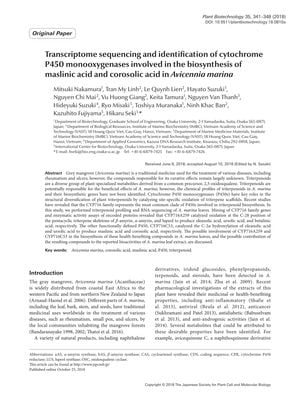Transcriptome Sequencing and Identification of Cytochrome P450 Monooxygenases Involved in the Biosynthesis of Maslinic Acid and Corosolic Acid in Avicennia Marina
October 2018
in “
Plant Biotechnology
”

TLDR Researchers found two enzymes in Avicennia marina that help produce maslinic acid and corosolic acid, which have medicinal benefits.
In the 2018 study, researchers sequenced the transcriptome of Avicennia marina leaves to identify cytochrome P450 monooxygenases (P450s) involved in the biosynthesis of maslinic acid and corosolic acid, compounds with medicinal properties. They discovered two P450 enzymes, CYP716A259 and CYP716C53, which catalyze the production of these triterpenoids. CYP716A259 was responsible for the oxidation of various triterpene skeletons, while CYP716C53 catalyzed the hydroxylation of oleanolic acid and ursolic acid to produce maslinic acid and corosolic acid, respectively. These findings provide insight into the biosynthesis of health-benefiting compounds in A. marina and may facilitate the use of these enzymes in synthetic biology for producing beneficial triterpenoids. The study also underscores the potential medicinal uses of maslinic acid and corosolic acid, with implications for their roles in anti-arthritic and antidiabetic activities.

